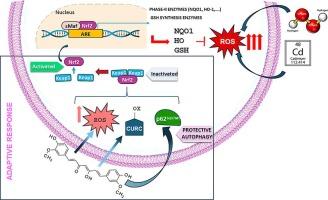姜黄素通过 Nrf2/ARE 信号转导和骨髓细胞自噬防止镉或 H2O2 引起的氧化应激反应
IF 3.6
Q2 BIOTECHNOLOGY & APPLIED MICROBIOLOGY
引用次数: 0
摘要
有证据表明,高浓度的环境污染物与慢性退行性疾病之间的联系令人震惊,而重金属(HM)被认为是一个关键因素。研究表明,饮食中的某些植物化学物质可以降低重金属水平,减轻其对健康的不利影响。本研究表明,用低剂量姜黄素(1 μM)预孵育已分化的 HL-60 和 K-562 人类髓系细胞,可显著防止镉和过氧化氢(H2O2)诱导的细胞毒性。莪术通过诱导细胞自噬这一与细胞稳态相关的过程,降低镉或过氧化氢产生的活性氧(ROS)水平。Curc 可激活轻度氧化应激,引发 Nrf2 依赖性转录物的表达,如核因子红细胞 2 相关因子 2(Nrf2)依赖性转录物,如人 NADPH 醌氧化还原酶 1(NQO1)和血红素氧化酶(HO1)。通过观察发现,在处理 5 分钟后,细胞内可检测到游离和未代谢的姜黄素,而且其存在与细胞内谷胱甘肽(GSH)水平的增加相平行,这加强了姜黄素对氧化还原压力的潜在化学预防作用。这些研究结果表明,以营养保健品的形式补充姜黄可能是保护生活在高污染地区的人们免受 HM 污染物不利影响的一种很有前景的方法。本文章由计算机程序翻译,如有差异,请以英文原文为准。

Curcumin prevents cadmium or H2O2-induced oxidative stress via Nrf2/ARE signaling and autophagy in myeloid cells
The evidence linking high levels of environmental pollutants to chronic degenerative diseases is alarming, with heavy metals (HM) identified as a key factor. Research suggests that certain phytochemicals in the diet can reduce HM levels and mitigate their adverse health effects.Curcumin (Curc), a natural polyphenol, is particularly effective in protecting against Cadmium (Cd) toxicity. The present study demonstrates that preincubation with low doses of Curc (1 μM) in differentiated HL-60 and K-562 human myeloid cells can significantly protect against cytotoxicity induced by Cd and or hydrogen peroxide (H2O2). Curc reduced the increased levels of Reactive Oxygen Species (ROS) generated by Cd or H2O2 by inducing a protective form of autophagy, a relevant process for the cellular homeostasis. Curc activated mild oxidative stress that triggers the expression of Nrf2-dependent transcripts, such as Nuclear factor erythroid 2-related factor 2 (Nrf2)-dependent transcripts, such as human NADPH Quinone Oxidoreductase 1 (NQO1) and Heme Oxygenase (HO1). The potential chemopreventive effects of Curc against redox stress have been strengthened by the observation that free and unmetabolized Curc is detectable inside the cells after 5 min of treatment, and its presence parallels with increased levels of intracellular Glutathione (GSH). These findings suggest that supplementation with Curc in the form of nutraceuticals may represent a promising way to protect people living in highly polluted areas against the adverse effects of HM contaminants.
求助全文
通过发布文献求助,成功后即可免费获取论文全文。
去求助
来源期刊

Current Research in Biotechnology
Biochemistry, Genetics and Molecular Biology-Biotechnology
CiteScore
6.70
自引率
3.60%
发文量
50
审稿时长
38 days
期刊介绍:
Current Research in Biotechnology (CRBIOT) is a new primary research, gold open access journal from Elsevier. CRBIOT publishes original papers, reviews, and short communications (including viewpoints and perspectives) resulting from research in biotechnology and biotech-associated disciplines.
Current Research in Biotechnology is a peer-reviewed gold open access (OA) journal and upon acceptance all articles are permanently and freely available. It is a companion to the highly regarded review journal Current Opinion in Biotechnology (2018 CiteScore 8.450) and is part of the Current Opinion and Research (CO+RE) suite of journals. All CO+RE journals leverage the Current Opinion legacy-of editorial excellence, high-impact, and global reach-to ensure they are a widely read resource that is integral to scientists' workflow.
 求助内容:
求助内容: 应助结果提醒方式:
应助结果提醒方式:


